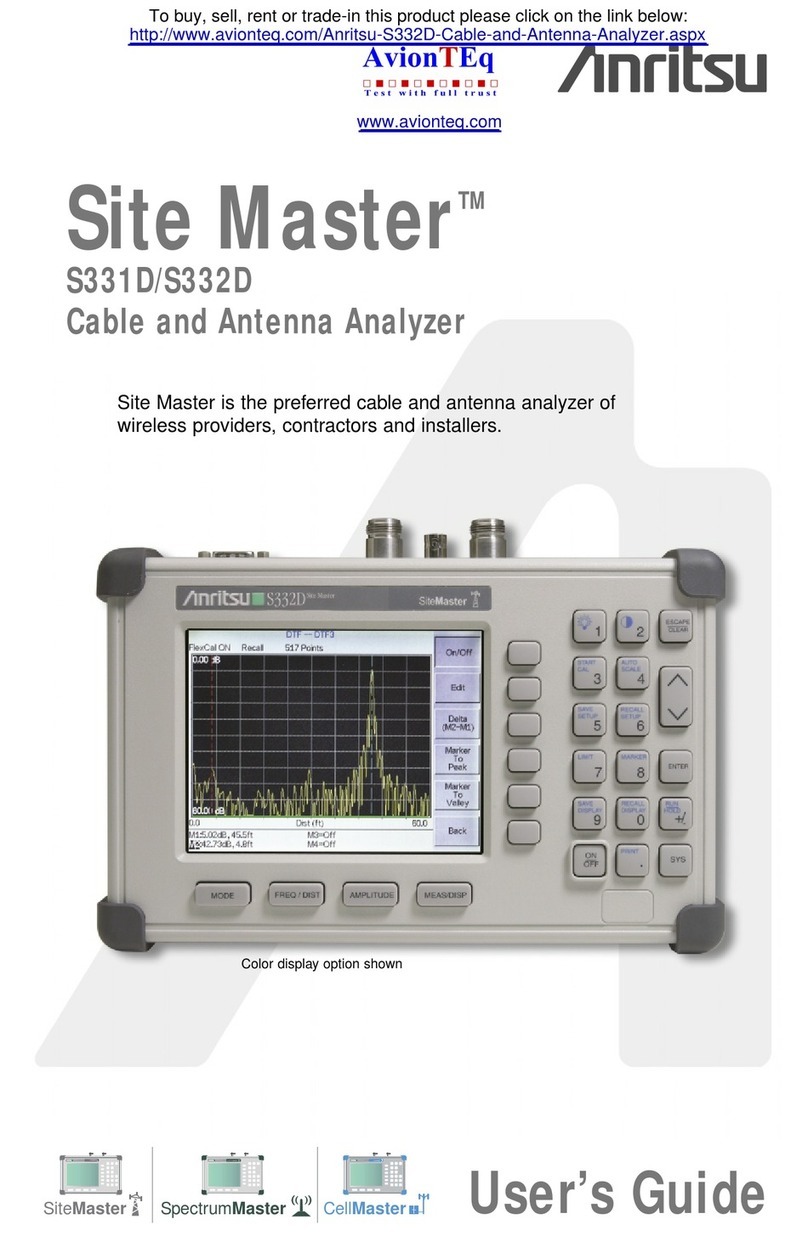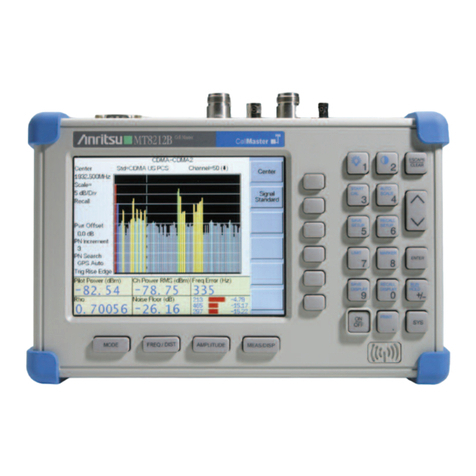
3
Blank Frequency Information: Blanking function removes all
references to frequencies on the display. Frequency references can
only be restored through a system reset or GPIB command.
Vector Error Correction:
There are six built-in methods of calibration:
Short-Open-Load-Thru (SOLT): This calibration method uses
short circuits, open circuits, and terminations (fixed or sliding).
Offset-Short (waveguide): This calibration method uses short
circuits and terminations.
LRL/LRM: The Line-Reflect-Line (LRL) or Line-Reflect-Match
(LRM) calibration uses transmission lines and a reflective
device
or termination (LRM).
TRM: The Thru-Reflect-Match calibration uses short circuits
and
fixed termination.
Three Offset-Short (SSST): This calibration method uses three
short circuits with different offset lengths to calculate all the
calibration terms.
Autocal: This calibration method uses an automatic calibrator
module.
There are four vector error correction models available for
calibration:
1) Full 12-Term
2) One Path/Two Port
3) Frequency Response
4) Reflection Only
Merged Calibrations: In addition, the Lightning D series VNAs have
a Merged Calibration feature that allows the user to merge
calibrations performed under different conditions (such as a low
frequency SOLT with a band-limited LRL) to cover different
frequency bands, provided the total number of points does not
exceed 1601.
AutoCal®:The VNA can internally control an external AutoCal
module to perform a 2-port OSLT calibration. AutoCal is a single
two port calibration module with built-in, switched, and
characterized OSLT standards. AutoCal provides quick, reliable,
and accurate calibrations that exceed the performance of a
standard broadband load OSLT calibration.
Calibration Standards: For coaxial calibrations the user can select
between SMA, 3.5 mm, GPC-7, Type N, 2.4 mm, TNC, K, V, W1
connector or special type from the calibration menu. Use of fixed
or sliding loads can be selected for each connector type. User
defined calibration standards allow for entry of open capacitance,
load and short inductances, load impedance, and reflection
standard offset lengths.
Reference Impedance: It is possible to modify the reference
impedance of the measurement to other than 50Ω (but not 0).
Adapter Removal Calibration: Built-in Adapter Removal application
software accurately characterizes and "removes" any adapter
used during calibration that will not be used for subsequent device
measurements. This technique allows for accurate measurement
of non-insertable devices.
Dispersion Compensation: Selectable as Coaxial (nondispersive),
Waveguide, or Microstrip (dispersive).
Power Meter Correction: Power meter correction is available at a
user-selectable power level, if it is within the power adjustment
range of the internal source. This is performed using an external
power meter over the Dedicated GPIB port
Multiple Source Control Capability: Multiple Source Control
capability allows a user to independently control the frequencies of
two sources and the receiver without the need for an external
controller PC. The frequency sweep may be comprised of up to
five separate bands, each with independent source and receiver
settings, for convenient testing of mixers, multipliers and other
frequency translated devices.
Set-On Receiver Mode: For applications that require Harmonics or
Intermodulation measurement, the 37000D can be configured to
measure the relative harmonic level of test devices with Set-On
Receiver Mode capability. The 37000D's unique phase locking
scheme allows it to operate as a tuned receiver by locking all of its
local oscillators to its internal crystal reference oscillator.
Embedding/De-embedding: All 37000D are equipped with an
Embedding/De-embedding feature. De-embedding is generally
used for removal of test fixture contributions and other S2P
networks from measurements. The de-embedding can be applied
to a calibration and then stored for future measurements. Similarly,
the Embedding function can be used to simulate matching circuits
for optimizing amplifier designs or simply adding effects of a
known structure to a measurement.
Electro-Optical Measurements
The 37000D series incorporated a de-embedding function that
simplifies VNA calibration when measuring E/O and O/E devices.
Characterize the transfer function, group delay, and return loss of
optical modulators (E/O) and photoreceivers (O/E) using the built-
in application.
E/O Measurements: The application menus guide the user through
the entire calibration and setup. A characterized photodiode (O/E)
reference and a laser source are required to complete the test
setup. The internal VNA application de-embeds the response of
the photodiode reference to allow direct measurement of the
bandwidth and return loss of the modulator.
O/E Measurements: Photoreceiver measurements can be made by
characterizing a modulator first and then using it as a transfer
standard for the O/E measurement. The internal application de-
embeds the response of the modulator to allow characterization of
the photoreceiver.
Gain Compression Measurements (37300D models only)
The 37300D series provide a user-intuitive Gain Compression and
AM/PM measurement application. The following two methods are
available for making gain compression measurements.
Swept Power Gain Compression: The VNA displays traditional
Power out vs. Power in or Phase vs. Power in, at one of up to 10
selectable CW frequencies. A separate screen will easily show
Power out and Power in at 1 dB or selected Gain compression for
all entered frequencies.
Swept Frequency Gain Compression: Once Gain is measured at
the starting power, the user increments Power in, observing
Normalized Gain vs. Frequency. This aids in analyzing the most
critical compression frequencies of a broadband amplifier.





























